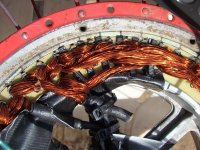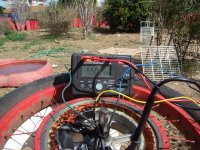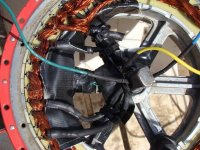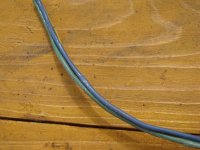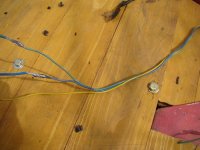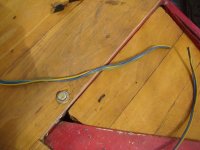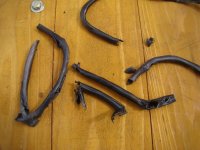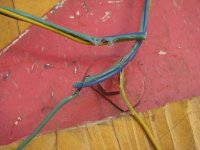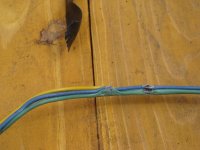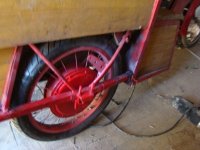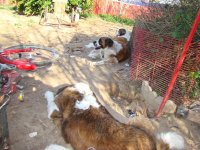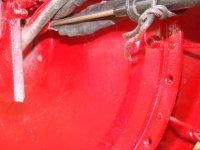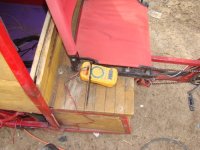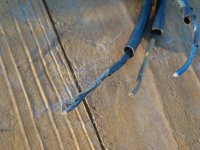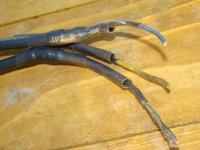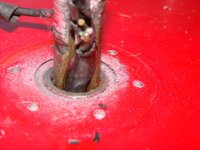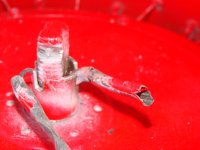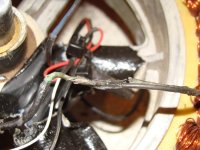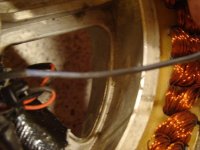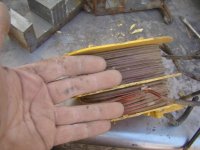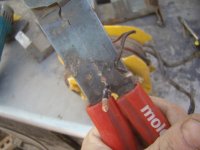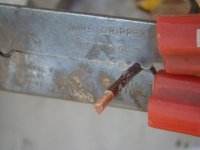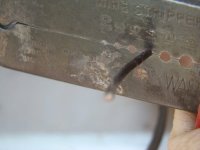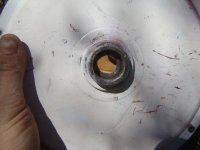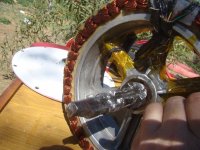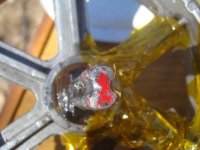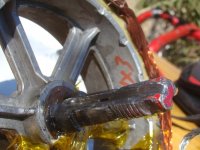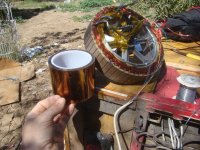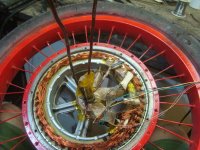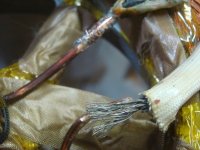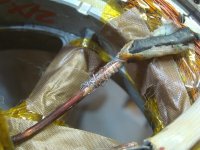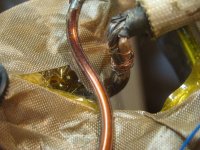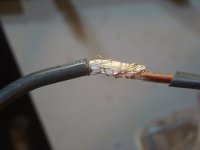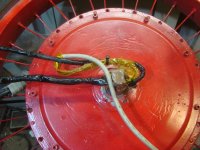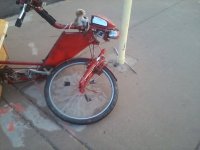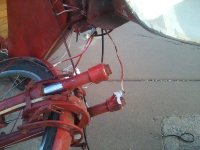Got interrupted for the above post....but some crappy news:
Short story long, the "blue" phase is shorted to the stator/axle, somewhere other than the phase wire itself (in the windings?).
Added some thin (unshrunk) heatshrink slipped over the teflon wire that will pass thru the axle bearing area, and the standoff tube (that spaces the motor face away from the dropout), so any rubbing will happen on the HS not the actaul wire insulation.
Tied down the wires to the (insulated with electrical tape layers) stator supports.
Then before installing any covers, I thought I should get the isolation tester out, and verify no shorts.
But it did have a short, even at the lowest isolation voltage range.
To simplify finding it, I undid the WYE point (kinda a PITA), so I could test each phase separately.
This showed the "green" and "yellow" phases (arbitrary colors as I'd installed the phase wires) were fine, 5.5gigohm to each other, the stator/axle, and the blue phase.
But the blue phase showed essentially a dead short to the stator/axle (and made quite a noise inside the tester, so I shut it off immediately).
A regular ohmmeter measurhed around 15kohm (where it said out of range, "infinite", for the other phases).
I undid the tiedowns for the blue phase, with the DMM still connected, and as I moved the wire away, the resistance when up to out of range.
Disconnected DMM and reconnected ioslation tester, and retested with the same 5.5gigohm result the ohter phases had.
SO the problem appeared to be somewhere between the WWCP and the end of the phase wire itself, where it passes along the axle/stator supports. However...that's triple insulated (at least) along it's whole length, and wasn't tied down mroe than loosely.
So i added another insulation alyer along the whole length of the path along the axle/stator supports, and loosely secured the wire...and a retest showed the same short back. :?
So it means the short would have to be at the point the windings themselves exit the last stator tooth, where the bend has to happen out of it, and it only shorts when it's bent over that point. I'll have to examine it closely, or just try to put something thin under it right there, and see if it fixes it.
AFAICT the entire area thru each stator tooth is lined with (probably) nomex, which sticks out well away from the surface of the stator laminations, and should not allow any shorts. So it sohdn't be possbile to have the issue I appear to be seeing.
But If not, I don't know where else it could be shorted.
IN theory it shouldn't affect the operation of the motor by a controller, for a regular sensored trapezoidal type, as long as nothing else shorts to the trike frame, or is grounded to it, etc.
But for something like the SFOC5, it might affect teh waveform sufficiently to cause indesirable operation in various ways (though I don't know what htose might be, offhand).
I hope I can either fix this issue, or that it will not affect the controller operation, as I really need to be able to use this motor wheel.
If I can't, I'll have to see about using the old Crystalyte X5304 instead...which means unlacing the rim / psokes off the MXUS 4503 and relacing to the X5304. Assuming, fo course, that the axle fix I did on that old motor works out ok (it's never been tested, due to the winding dmage I did to it during the axle repair...which hopefully doesn't cause a problem, either).
Short story long, the "blue" phase is shorted to the stator/axle, somewhere other than the phase wire itself (in the windings?).
Added some thin (unshrunk) heatshrink slipped over the teflon wire that will pass thru the axle bearing area, and the standoff tube (that spaces the motor face away from the dropout), so any rubbing will happen on the HS not the actaul wire insulation.
Tied down the wires to the (insulated with electrical tape layers) stator supports.
Then before installing any covers, I thought I should get the isolation tester out, and verify no shorts.
But it did have a short, even at the lowest isolation voltage range.
To simplify finding it, I undid the WYE point (kinda a PITA), so I could test each phase separately.
This showed the "green" and "yellow" phases (arbitrary colors as I'd installed the phase wires) were fine, 5.5gigohm to each other, the stator/axle, and the blue phase.
But the blue phase showed essentially a dead short to the stator/axle (and made quite a noise inside the tester, so I shut it off immediately).
A regular ohmmeter measurhed around 15kohm (where it said out of range, "infinite", for the other phases).
I undid the tiedowns for the blue phase, with the DMM still connected, and as I moved the wire away, the resistance when up to out of range.
Disconnected DMM and reconnected ioslation tester, and retested with the same 5.5gigohm result the ohter phases had.
SO the problem appeared to be somewhere between the WWCP and the end of the phase wire itself, where it passes along the axle/stator supports. However...that's triple insulated (at least) along it's whole length, and wasn't tied down mroe than loosely.
So i added another insulation alyer along the whole length of the path along the axle/stator supports, and loosely secured the wire...and a retest showed the same short back. :?
So it means the short would have to be at the point the windings themselves exit the last stator tooth, where the bend has to happen out of it, and it only shorts when it's bent over that point. I'll have to examine it closely, or just try to put something thin under it right there, and see if it fixes it.
AFAICT the entire area thru each stator tooth is lined with (probably) nomex, which sticks out well away from the surface of the stator laminations, and should not allow any shorts. So it sohdn't be possbile to have the issue I appear to be seeing.
But If not, I don't know where else it could be shorted.
IN theory it shouldn't affect the operation of the motor by a controller, for a regular sensored trapezoidal type, as long as nothing else shorts to the trike frame, or is grounded to it, etc.
But for something like the SFOC5, it might affect teh waveform sufficiently to cause indesirable operation in various ways (though I don't know what htose might be, offhand).
I hope I can either fix this issue, or that it will not affect the controller operation, as I really need to be able to use this motor wheel.
If I can't, I'll have to see about using the old Crystalyte X5304 instead...which means unlacing the rim / psokes off the MXUS 4503 and relacing to the X5304. Assuming, fo course, that the axle fix I did on that old motor works out ok (it's never been tested, due to the winding dmage I did to it during the axle repair...which hopefully doesn't cause a problem, either).


